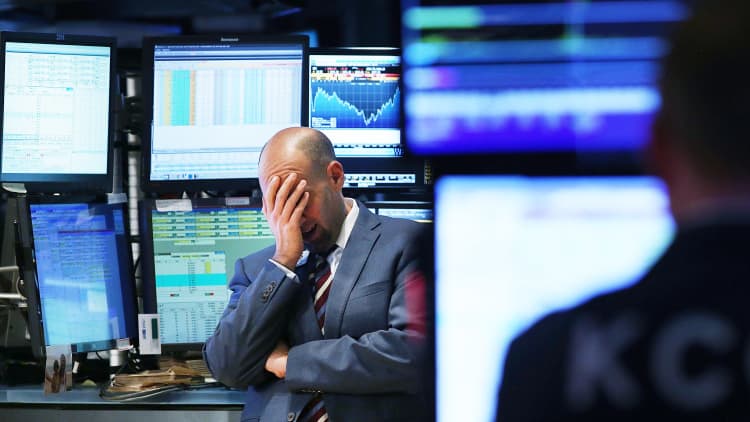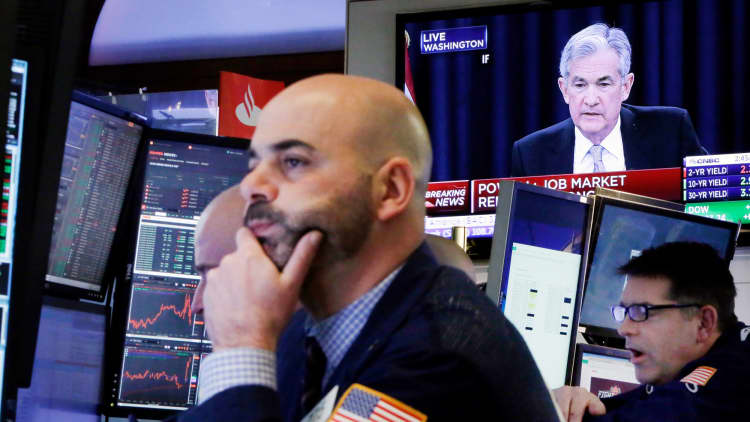
Stocks fell sharply on Thursday in a second straight scary day on Wall Street as investors dumped equities around the globe because of fears of rapidly rising interest rates, a possible global economic slowdown and overly ambitious tech valuations.
The Dow Jones Industrial Average closed 545.91 points lower at 25,052.83, bringing its two-day losses to more than 1,300 points. The dropped 2.1 percent to 2,728.37 and posted its sixth straight decline. The broad index also closed below its 200-day moving average for the first time since April. The Nasdaq Composite pulled back 1.3 percent to 7,329.06 and briefly entered correction territory at its lows on Thursday.
The Dow fell as much as 698.97 points at its lows of the day. The indexes bounced after a report said President Donald Trump and Chinese President Xi Jinping would meet at next month's G-20 summit, briefly giving traders hope a full-blown trade war with the country could be avoided.
October, a month known for major market sell-offs in the past, has been a brutal month for investors so far. The S&P 500 has lost 6 percent during the month so far and is now higher by just 2 percent for 2018.
The financials sector was the second-worst performer on the S&P 500, dropping nearly 3 percent. J.P. Morgan Chase fell 3 percent, while Citigroup dropped 2.2 percent. Wells Fargo slipped 1.9 percent.
Treasury yields pulled back from multiyear highs, with the benchmark 10-year yield sliding to 3.13 percent. The two-year yield also fell to 2.84 percent. The iShares 20+ Year Treasury Bond ETF (TLT) jumped 1.2 percent as investors clamored into bonds for safety.
The major indexes fell after some of the major tech names failed to recover from steep losses in the previous session. Netflix fell more than 1 percent after briefly trading higher. Apple also declined 0.9 percent, erasing earlier gains. Amazon dropped 2 percent after falling 6.2 percent on Wednesday.
"It's a momentum correction, not a portfolio correction," said Joe Terranova, chief market strategist at Virtus Investment Partners. "While we have a bias to believe 2008 could happen again, I don't think this is the case."
"Less is more in this environment," Terranova added. "I think you need to be an observer of the guidance you get in earnings."

Gold futures surged 2.6 percent to $1,224.60 per ounce. The Cboe Volatility index (VIX), widely considered as the best gauge of fear in the market, rose to its highest level since Feb. 12 on Thursday.
"As markets slide further and investors seek other safe havens like options for protection, we could see higher VIX levels moving forward," said Jeff Chang, managing director at Cboe Vest.
Tech shares fell more than 4.5 percent on Wednesday, marking their worst day since 2011. The sell-off led to the Dow sinking more than 800 points and the S&P 500 dropping more than 3 percent.
Run-up in rates
Investors had been fretting over a sharp rise in yields fears that rising borrowing costs could slow down the economy. Those fears were quelled slightly by the release of weaker-than-expected inflation data. The U.S. government said the consumer price index rose 0.1 percent in September, well below the expected gain of 0.2 percent.
"Net, net, the economy may be running hot, but it isn't fast enough to kick up inflation pressures and calls into question the need for Fed policymakers to move interest rates to higher levels," Chris Rupkey, chief financial economist at MUFG Union Bank, said in a note.
The recent downturn in equities comes as investors brace for the upcoming earnings season. J.P. Morgan Chase and Citigroup are among the companies scheduled to report Friday before the bell.
Expectations are high for this earnings season. Analysts polled by FactSet expect S&P 500 earnings to have grown by 19 percent in the third quarter.
"We look at this as a buying opportunity," said Dryden Pence, chief investment officer at Pence Wealth Management. "I would have my shopping cart out here."
"The question is whether the market bounces off a 5 percent or a 10 percent drop," he said. "I think we're going to bounce around here for a while."
Thursday's sell-off was accompanied by strong volume. The SPDR S&P 500 ETF (SPY) traded nearly 260 million shares on the day, well above its 30-day average of 72.8 million.







